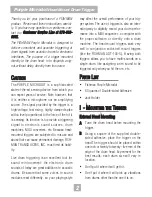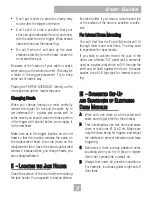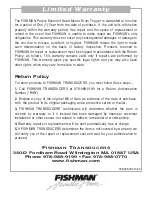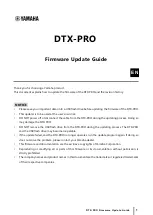
3
3
•
Don’t put it where a stand or clamp may
touch either the trigger or the wire.
•
Don’t put it in such a position that your
stick can get underneath the cord and sepa-
rate the cable from the trigger. Wrap excess
cable wire around the nearest lug.
•
Do put it where it will pick up the most
vibrations directly from the head; locate the
most sensitive spot.
Be aware of the location of your cable or snake
when wiring up the whole drum kit. This may be
a factor in the trigger placement. Try to keep
wires out of harm's way.
Placing the PURPLE MICRODOT directly on the
rim may be an option; results may vary.
C
Chhaannggiinngg H
Heeaaddss
When you change heads you must carefully
remove the trigger. Do not pull the cable, try to
get underneath it - a guitar pick works well. In
some cases you should clean the brass portion
of the trigger with alcohol before you re-apply it
to the new head.
Make note as to the trigger location on the old
head so that the location remains the same on
the replacement head; this cuts down on the
readjustment time. Save the extra double-sided
adhesive, because when you change heads you
also change adhesive.
IIII -- LL
O
OC
CA
ATTIIN
NG
G TTH
HEE
JJ
A
AC
CK
K
H
H
O
OLLD
DEER
R
Clean the surface of the drum before mounting
the jack holder. You may wish to find an alterna-
tive jack holder if you have a custom paint job
or the surface of the drum is sensitive to adhe-
sive.
FFoorr IInntteerrnnaall D
Drruum
m M
Moouunnttiinngg
You will find that the Purple Microdot will fit
through most round vent holes. You may wish
to experiment for best results.
If you wish to custom mount the jack in the
drum, use a female 1/4” panel jack (commonly
used as a guitar jack) which will fit through the
shell and sit flush against the drum; the same
applies to an XLR type jack for internal mount-
ing.
IIIIII -- S
S
U
UG
GG
GEES
STTEED
D
S
S
EETT
--U
U
P
P
A
AN
ND
D
S
S
H
HA
AK
KEED
DO
OW
WN
N O
OFF
EE
LLEEC
CTTR
RO
ON
NIIC
C
D
D
R
RU
UM
M
M
M
O
OD
DU
ULLEES
S
A
A Work with one drum at a time (start with
snare drum to get a feel for the process).
B
B Test combinations like kick drum and snare
drum or rack toms #1 & #2, etc. Make sure
only the drum being hit triggers, and adjust
the interface to prevent interaction and false
triggering.
C
C Determine if there are any phantom notes
sounding when you hit or play on targets
like hi-hat, cymbal hits, cowbell, etc.
D
D Always test under all possible conditions.
For example, loud bass guitar might set off
floor toms.
U s e r G u i d e
U s e r G u i d e














